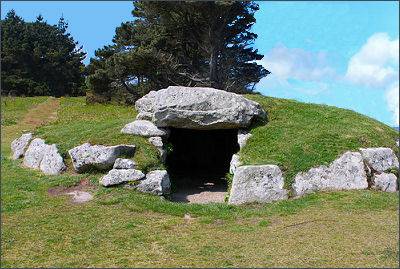Porth Hellick Down Burial Chamber
OS grid reference :-SV 928107
 A large and imposing Scillonian Bronze Age entrance grave stands on Porthellick Down, on the south coast of the Island of St. Mary's. The well preserved and impressive monument has an inner passage, burial chamber and kerb al intact.
A large and imposing Scillonian Bronze Age entrance grave stands on Porthellick Down, on the south coast of the Island of St. Mary's. The well preserved and impressive monument has an inner passage, burial chamber and kerb al intact.
The Great Tomb, as it is sometimes known, dates from about 2000 BC. It is the largest and best preserved entrance grave in a scattered cemetery that includes six others, and two low cairns. Entrance graves are perhaps the most impressive of Bronze Age monuments, and the example at Porth Hellick Down is typical in its design.
The monument has a 12 metre diameter and a central burial chamber measuring 3 metres long and 1 metre high, which is covered with 4 capstones. An unroofed passage 4.2 metres long leads to the inner chamber. The passageway curves into the chamber which then curves off the other way, forming a rough S shape.
The archeologist George Edward Bonsor excavated the burial chamber in 1899 but discovered only Bronze Age pottery and reported that the tomb had already been cleared out.
Porthellick Down burial chamber is now in the care of English Heritage.